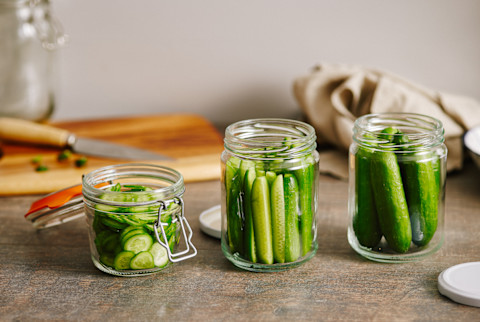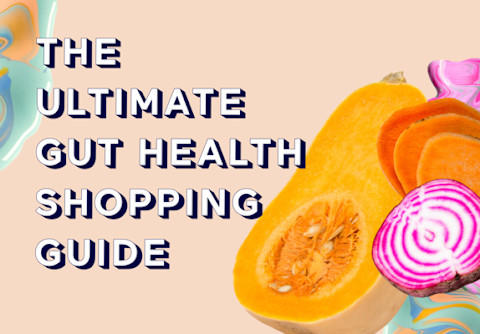Why You Should Make Your Own Pickles + How To Make Them At Home

When a pickle craving hits, there's not much else that can satisfy the need for a crisp, crunchy, tangy treat. But it turns out, a pickle isn't always a pickle.
"It's important to know there are pickles and then there are pickles!" says nutrition consultant and natural chef Karyn Forsyth Duggan, M.S., BBS. "The classic store-bought pickled vegetables are simply pickled in vinegar and then canned/jarred so they're shelf-stable. There's really no comparison between these pickled foods and foods that have actually been fermented."
You've probably heard a lot about the health benefits of fermented foods, but what's the real advantage of including them in your diet? "Fermented foods are so amazing for your health because they're full of phenomenal probiotics and the vegetables are full of prebiotic goodness—food for the good bacteria in your digestive system that keep you healthy and well," says life coach and holistic nurse practitioner Victoria Albina, N.P., MPH. "I also love pickling or fermenting because it's such a great way to get more vegetables in your diet."
The benefits of making your own pickles at home.
But, as Duggan pointed out, "pickling" isn't always what happens to the pickles you find in stores.
"Pickled foods can be made via fermentation," says Megan Meyer, Ph.D., director of science communications at the International Food Information Council. "Fermentation is a process where bacteria or yeast convert sugars found in foods into lactic acid or alcohol. Foods that are fermented via lactic acid fermentation impart the tangy flavor associated with foods like yogurt, kimchi, sauerkraut, and pickles."
"[Pickles] are often loaded with probiotics, the healthy bacteria that can provide a host of benefits to our gut health!" says registered dietitian nutritionist Leah Silberman, RDN.
But when it comes to the store-bought variety, Silberman says, buyer beware. "They're typically high in sodium, so watch for that. Also, I recently noticed a particular brand used artificial colors in their pickles to provide a more vibrant yellow/greenish hue. Yellow 5 is not a food! Be sure to stay away from those artificial additives."
"When buying pickled foods that are pickled with a slow fermentation, you'll benefit from natural probiotics that support the microbiome," says sports dietitian Kelly Jones, M.S., R.D., CSSD. "The microbiome, or all the bacteria and microbes living in and on the body, is linked to immunity, mental health, metabolism, and more1.
Because fermented foods are made with the help of microorganisms, they're often classified as "probiotics," but Meyer says it's important to be cautious with that categorization, particularly when purchasing pickles from the store.
"To be considered a probiotic, the microorganisms found in the food have to have known health benefits," she says. "Bottom line: if you are buying pickles from a can at a grocery store, there's very little chance there's any probiotics in them. If you are buying them at a farmers market or making them yourself, there will most likely be microorganisms in the pickles but it's often not clear the type, diversity, and amount of the microorganisms."
"Store-bought pickles are often heat-treated to make them shelf-stable, which kills off the beneficial bacteria," Albina says. "Many often have added preservatives and stabilizers, and sadly several store brands have food dye in them, all of which I try to avoid whenever I can. Luckily, homemade fermented and pickled foods are so quick and easy to make at home, avoiding those chemicals."
How to make true homemade pickles: the basics.
So you're ready to start your own home pickling...how exactly do you dive in? While it may sound intimidating, the process is super simple and can even help the planet since you'll be limiting food and packaging waste. "To ferment pickles at home, it will require more effort and special attention so that your pickles don't spoil. Dietitian Rachael Hartley makes it seem easy, though, with her three recipes for homemade fermented pickles."
You'll need a few supplies to get started:
- Jars
- Vegetable of choice (see below suggestions—there are so many more options than cucumbers!)
- Vinegar
- Salt
- Garlic
- Spices or herbs of choice
Every recipe is a bit different, but one simple, straightforward method is to pack a Mason jar with garlic and herbs. Then dissolve salt in hot water and add vinegar before pouring into the jar. Seal the jar loosely or cover it with some cheesecloth, and let it sit in a dark spot for a few days, waiting for bubbles to emerge. The more sour you'd like your pickles to be, the longer they'll need to ferment outside the fridge.
How to make refrigerator or "quick" pickles.
If you're in a time crunch or are still a little intimidated by the idea of setting up a fermentation station in your kitchen, you can still get in on the homemade pickle game by making a "quick pickle."
"You can make a quick pickle by adding thinly sliced or julienned veggies such as onions, cabbage, or carrots to a small saucepan and heating them with red wine or apple cider vinegar as well as a touch of raw honey and salt," Jones says. "While this would not offer probiotics, the acid from the vinegar may have a positive benefit on digestion."
"I love to do a quick pickle with vegetables like cucumbers, radishes, carrot sticks using equal parts water and vinegar (white vinegar, apple cider, white wine, and rice vinegar all work well)," Albina says. "I add lots of yummy herbs and spices and let the pickles sit for just a day or two before they're delightfully yummy to eat. I keep a quick pickle in the fridge."
9 vegetables you can use in pickles, other than cucumbers.
"I love pickling fruits and veggies at home," says registered dietitian and integrative nutrition health coach Jessica Cording, M.S., R.D., CDN, INHC, noting that a few of her favorites are these DIY pickled red onions and pickled strawberries. "I also love pickled cauliflower, cucumbers, and carrots."
"Dill is my favorite herb to use for pickling," says holistic nutritionist Mandy King, CNP, NNCP, BCom. "You'd be surprised how many other pickled veggies taste great with dill. Pickled carrots and green beans with dill are fantastic!"
A few other veggies to try in your pickle experimentation:
- Carrots
- Cauliflower
- Radishes
- Green beans
- Broccoli stems
- Asparagus
- Beets
- Pearl onions
- Jalapeño
The bottom line.
Fermented foods are fantastic for gut health, but store-bought pickles often lack all the benefits. You can make your own pickles at home, either by throwing together a quick concoction of veggies and vinegar or by following a step-by-step tutorial for proper at-home fermentation.

